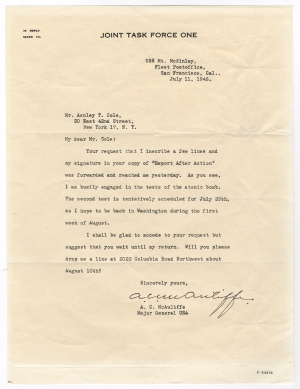|
Anthony C. McAuliffe Writes Amidst Tests of Atomic Bombs at Bikini Atoll in 1946 |
Click to enlarge:

In this brief letter, General A. C. McAuliffe agrees to inscribe a copy of a unit history of the 103rd Infantry Division for the New York attorney and autograph collector Ashley T. Cole after he returns to Washington from atomic tests in the Pacific Ocean. This letter was written between the test denotations of the fourth and fifth atomic bombs ever exploded.
Unit historians Ralph Mueller and Jerry Turk wrote Report after Action: The Story of the 103rd Infantry Division with illustrations by artist Bill Barker, and it was published in 1945. Because McAuliffe led the 103rd through the end of the war in Europe, Cole wanted to get his autograph on the brief volume.
ANTHONY C. McAULIFFE.
Typed Letter Signed, to Ashley T. Cole, July 11, 1946, USS
Mt. McKinley, Fleet Postoffice, San Francisco, California; on
“Joint Task Force One” stationery. 1 p., 8 x 10½ in.
Inventory #26778
Price: $750
Excerpt
“Your request that I inscribe a few lines and my signature in your copy of ‘Report After Action’ was forwarded and reached me yesterday. As you see, I am busily engaged in the tests of the atomic bomb. The second test is tentatively scheduled for July 25th, so I hope to be back in Washington during the first week of August.
“I shall be glad to accede to your request but suggest that you wait until my return.”
Historical Background
On January 11, 1946, the United States government established Joint Task Force One and began gathering ships and resources to complete Operation Crossroads. The mission was to test atomic weapons on target vessels. By June, organizers had assembled more than one hundred ships, scores of aircraft, and more than 42,000 servicemen around Bikini Atoll in the Marshall Islands. The U.S. Navy wanted to know if atomic bombs had made surface fleets obsolete. Could ships survive the blast and still be effective?
The Marshall Islands consisted of 29 coral atolls located in the Pacific Ocean between Hawaii and Australia, with a combined population of over 52,000. When authorities selected Bikini as the test site, they forcibly relocated the 167 people living on the island to another island 125 miles away and told them that they could eventually return.
On July 1, 1946, Shot Able, a 23-kiloton bomb was detonated 520 feet above the target fleet at anchor. All of the target ships had sailed to Bikini with full crews, but the crews were removed to an area 22 miles away for the test. The bomb missed its target, the USS Nevada but did sink five ships, including two troop transports, two destroyers, and a surrendered Japanese cruiser.
Shot Baker, a bomb of the same type, exploded on July 25, but it was suspended 90 feet below a ship in the center of the fleet, making it the first underwater atomic explosion. The blast shot an estimated 2 million tons of water in a massive column into the sky. In the wake of the shockwave and falling water, nine ships sank.
Although Shot Able did not leave a large amount of radiation on the ships, Shot Baker spread a huge amount of radioactive material across the island and the target ships, so much that the organizers canceled Shot Charlie and evacuated the crews.
Anthony C. “Nuts” McAuliffe (1898-1975) was born in Washington, D.C., and graduated from the U.S. Military Academy at West Point in 1918. Assigned to field artillery, he graduated from the Artillery School in 1920. He remained in the Army and gained promotion to the rank of captain by 1935. He graduated from the U.S. Army War College in 1940. He gained promotion to lieutenant colonel in the supply division and supervised the development of new technology such as the bazooka and the jeep. Brigadier General McAuliffe commanded the artillery for the 101st Airborne Division and parachuted into Normandy on D-Day in 1944. Temporarily in command of the 101st Airborne during the Battle of the Bulge, McAuliffe and his troops were besieged by a larger force of Germans at Bastogne, Belgium. When the German general demanded his surrender, McAuliffe responded with the answer, “Nuts!” which became his nickname. The 101st held Bastogne for four days before the 4th Armored Division arrived to reinforce the Americans. McAuliffe received the Distinguished Service Cross from General George S. Patton four days later. For the next seven months, McAuliffe commanded the 103rd Infantry Division as it entered Germany and Austria. After the war, McAuliffe held several positions, including Chief Chemical Officer of the Army Chemical Corps and Head of Army Personnel. He returned to Europe in 1953 as Commander of the Seventh Army and became Commander-in-Chief of the United States Army Europe in 1955. He resigned from the army as a four-star general in 1956. He was vice president for personnel of the American Cyanamid Corporation from 1956 to 1963.
Ashley T. Cole (1876-1965) was born in New York City and graduated from Columbia University and the New York Law School. He began practicing law in 1900 and was legal counsel for the Union Carbide and Carbon Corporation in 1916. He was a member of the New York World’s Fair Commission from 1936 to 1941 and Chairman of the New York State Racing Commission from 1945 to 1965. The Ashley T. Cole Handicap, named for him, for New York-bred horses has been run annually since 1976 at Belmont Park. He collected military and other autographs and assembled, according to the New York Public Library, “one of the most impressive collections of material anywhere at the time.”